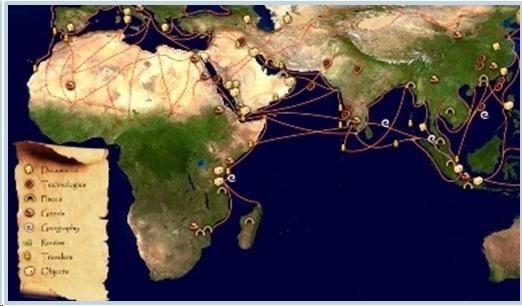

Medieval Trade Routes - The Silk Road and Indian Ocean Maritime Network
Here, I would like to begin by defining the term globalization. Briefly, "globalization" means the breaking down of traditional boundaries in the face of increasingly global financial trends. In other words, globalization is a move towards political, financial, and cultural interactions between people traditionally separated by geographical distance, as well as by political and social boundaries. In the modern world, this has become the norm, as the digital revolution allows us to email, Facebook, and even Twitter each other. In other words, in our modern world computers allow us to connect in real time with peoples across the globe, whether for personal, financial, or political reasons. This ease of contact and communication was not remotely the case in the pre-modern world, when communication and travel took tens of times more than they do today. In effect, the pre-modern world was one in which peoples around the globe lived mostly in relative isolation; the majority of ancient and medieval people rarely traveled long distances and rarely came into contact with peoples outside their immediate locality. This isolation was, of course, intermittently broken by warfare and invasions, for example when nomadic peoples moved in and conquered settled communities. Another way in which this isolation was broken was through trade, as we will see. / Perhaps the most important result of the breaking of geographical barriers was the sharing of experiences and the exchange of ideas. Therefore, our focus here is not just on the "factual" information regarding the nature of these trade networks, but also on the acculturation made possible through them. As you should already know (since it is one of the terms we have been using throughout our class), acculturation is the selective borrowing and subsequent "tweaking" and making your own of other peoples' ideas (like technologies, religions, political models, etc.). Clearly, acculturation requires that two different cultures come into contact, a process which was most effectively facilitated by long-distance trade, which moved not only material goods, but also people. These people, in turn, brought with them their own ideas and ways of doing things, which were often embraced by others along the trade routes. / We will speak about specific exchanges in later slides, so for now I want to highlight instead five core changes which long-distance trade brought to World History: 1) long-distance trade made locally accessible foreign products that would otherwise not have been available. These products, in turn, changed people's tastes, aesthetics, and even the way in which simple everyday tasks were completed; 2) long-distance trade brought unprecedented wealth and led to investment in technological innovations which would create even greater profits; 3) global trade also enabled people to concentrate their efforts on economic activities best suited to their regions (basically an extreme, and global rather than local, version of specialization); 4) long-distance trade also facilitated the spread of religious traditions beyond their original homelands; and 5) it also facilitated the transmission of disease. This last point highlights that global contact is, of course, not always for the better.